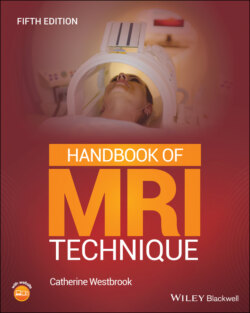Читать книгу Handbook of MRI Technique - Catherine Westbrook - Страница 17
EQUIPMENT
ОглавлениеThis contains a list of the equipment required for each examination and includes coil type, gating leads, bellows and immobilization devices. The correct use of gating and RC is discussed in Part 1 (see Gating and respiratory compensation techniques). The coil types described are the most common currently available. These are as follows.
Volume coils that both transmit and receive radiofrequency (RF) pulses and are specifically called transceivers. Most of these coils are quadrature in design, which means that they generate two RF fields perpendicular to each other. This maximises coupling between the coils and the spin population, thus improving image quality factors such as the signal‐to‐noise ratio (SNR). Volume coils often encompass large areas of anatomy and yield a uniform signal across the whole field of view (FOV). The head and body coil are examples of this type of coil.
Linear phased array coils consist of multiple coils and receivers. The signal from the receiver of each coil is combined to form one image. The image has the advantages of both a small coil (improved SNR) and those of the larger volume coils (increased coverage). Therefore, linear phased array coils can be used either to examine large areas such as the entire length of the spine, or to improve signal uniformity and intensity in small areas such as the breast.Figure 1.1 Correct placement of a flat surface receive coil.
Volume phased array (parallel imaging) uses the data from multiple coils or channels arranged around the area under examination to decrease scan time, increase phase resolution or a combination of both. Additional software and hardware are required. The hardware includes several coils perpendicular to each other or one coil with several channels. The number of possible coils/channels varies but currently ranges from 2 to 32 for routine imaging and up to 128 for cardiac imaging. During data acquisition, each coil fills its own lines of k‐space (e.g., if two coils are used together, one coil fills the even lines of k‐space and the other the odd lines. k‐space is therefore filled either twice as quickly or with twice the phase resolution in the same scan time). The number of selected coils/channels is generically called the reduction factor and is similar in principle to the turbo factor (TF)/echo train length (ETL) in fast or turbo spin echo (FSE/TSE) (see Pulse sequences). Every coil/channel produces a separate image that often displays aliasing artefact (see Flow phenomena and artefacts). Software called sensitivity encoding and additional algorithms remove this artefact and combine the images from each coil/channel to produce a single unwrapped image. This technology can be used in most examination areas and with any pulse sequence. It is often discussed in the Protocol optimization section in Part 2.
Surface/local coils are traditionally used to improve the SNR when imaging structures near to the skin surface. They are often specially designed to fit a certain area and in general they only receive signal. Surface coils increase SNR compared with volume coils. This is because they are placed close to the region under examination increasing signal amplitude that is generated in the coil, while noise is only received in the vicinity of the coil. However, surface coils only receive signal up to the edges of the coil and to a depth equal to the diameter of the conductive loop of the coil. To visualize structures deep within the patient, either a volume, linear or volume phased array coil or, more rarely, a local coil inserted into an orifice must be utilized (e.g., a rectal coil).
The choice of coil is one of the most important factors that determines the SNR. When using any type of coil remember to:
Check that the cables are intact and undamaged.
Check that the coil is plugged in properly and that the correct connector box is used.
Ensure that the receiving side of the coil faces the patient. This is usually labelled on the coil itself. Note that both sides of the coil usually receive signal, but coils are designed so that one side receives optimum signal. This is especially true of shaped coils that fit a certain anatomical area. If the wrong side of the coil faces the patient, signal is lost, and image quality suffers.
Place the coil as close as possible to the area under examination.
The coil should not directly touch the patient’s skin as it may become warm during the examination and cause discomfort. A small foam pad placed between the skin surface and the coil is usually sufficient insulation.
Ensure that the coil does not move when placed on the patient. A moving coil during data acquisition always produces a moving image.
Ensure that the receiving surface of the coil is parallel to the z (long) axis of the magnet. This guarantees that the transverse component of magnetization is perpendicular to the coil and that maximum signal is induced. Placing the coil at an angle to this axis, or parallel to the x or y axis, results in a loss of signal (Figure 1.1). Note that the axes discussed here relate to a superconducting magnet. Open systems may label their axes differently, but the principle remains the same. To generate signal in a receiver coil on any type of system, the receiver coil must be located perpendicular to the transverse component of magnetization.
